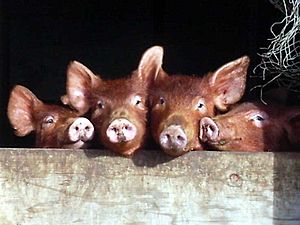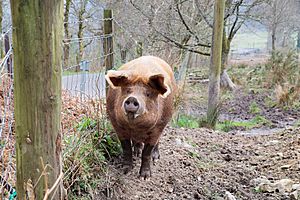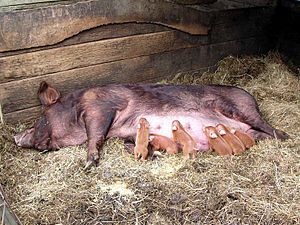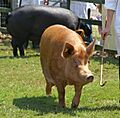Tamworth pig facts for kids

Tamworth piglets
|
|
| Conservation status | Vulnerable |
|---|---|
| Country of origin | United Kingdom |
| Traits | |
|
|
The Tamworth pig, also called Sandy Back or Tam, is a special kind of domestic pig. It first came from a place called Tamworth in the United Kingdom. This breed is one of the oldest pig breeds around!
Sadly, there aren't as many Tamworth pigs today as there used to be. They are not often used in big farms anymore. Because of this, they are considered "Threatened" in the United States and "Vulnerable" in the UK. This means we need to help protect them!
Tamworth pigs are usually ginger or red in color. People think they are related to wild boars from Europe. Today, you can find these pigs mainly in the United Kingdom, Australia, the United States, New Zealand, and Canada.
Contents
What Does a Tamworth Pig Look Like?

Tamworth pigs have a unique look. They have a long head and a long, narrow body. Their ears stand up straight and are pointed. Their snout is also quite straight.
Their color can be light ginger or a darker reddish-brown. Long ago, some were orange and purple, but breeders worked to remove the orange color. Their thick hair helps protect their skin from the sun. However, when they shed their hair in summer, they like to find shade. They also love to cover themselves in mud to stay cool and prevent sunburn, because pigs can't sweat!
Size and Features
Tamworth pigs are a medium-sized breed. A full-grown male pig, called a boar, usually weighs between 250 to 370 kg (550 to 820 lb). A female pig, called a sow, weighs about 200 to 300 kg (440 to 660 lb).
They are typically 100 to 140 cm (39 to 55 in) long and about 50 to 65 cm (20 to 26 in) tall. Their curly tail is usually 24 to 30 cm (9.4 to 12 in) long. Tamworths have long necks and legs, with deep sides. Their back is narrow, but their ham muscles are strong. They also have strong feet and bones.
When a Tamworth sow has babies, called piglets, she usually has fewer than other farm pig breeds. Things that are not wanted in a Tamworth pig include curly hair, a rough mane, a nose that turns up, or dark spots on their coat.
How Do Tamworth Pigs Behave?
One of the best things about Tamworth pigs is how tough they are. They can handle cold and windy weather very well. This is why they do great in places like Scotland and Canada, where winters are harsh.
These pigs are not just tough; they are also very good at finding food in forests. They can even eat bracken, which is a type of fern. Tamworths can graze with cows, eating the food the cows leave behind. However, they can be a bit protective of their space and might be aggressive towards other animals in the same field.
Finding Food and Raising Piglets
Tamworth pigs are excellent at digging for food in forests or pastures. Farmers often use them in farming systems where animals find their own food.
Female Tamworth pigs (sows) are great mothers. They make sure all their littermates (baby pigs from the same birth) get enough milk. A sow usually has between six and ten piglets. When piglets are born, they can be a bit shy of humans at first. But they quickly get used to people. Tamworth pigs generally have a good personality and enjoy attention from humans.
History of the Tamworth Pig
The Tamworth pig breed started near the town of Tamworth in England. This happened at Sir Robert Peel's Drayton Manor. Around 1812, the pigs there were bred with "Irish Grazers," a type of pig Sir Robert Peel saw in Ireland. Most of the improvements to the breed happened in areas like Staffordshire and Warwickshire in England. These pigs are very similar to the original wild forest pigs of Europe.
In 1865, the Tamworth pig was officially recognized as a breed in England. Later, in 1885, a special book was started to keep track of all the Tamworth pigs. The first Tamworths came to the USA in 1882. Soon after, they arrived in Canada, where they also became popular.
Today, there are groups in the UK, USA, and Canada that work to protect Tamworth pigs. While other pig breeds are more common, Tamworths were quite popular in Canada from 1913 to the mid-1900s, making up about 10% of all pigs. In Australia, their numbers peaked around 1,000 in the mid-20th century. Now, there are just enough of these pigs to keep the breed going in these five countries.
Tamworth Pig Genetics and Conservation
Tamworth pigs are genetically different from most modern farm pigs. This makes them great for cross-breeding with other pig types. They are sometimes called "bacon pigs" because they can grow a lot of muscle without having too much fat.
In 2018, there were these many breeding female Tamworth pigs:
- USA: 1,000
- United Kingdom: 340
- Canada: 254
- Australia: 55
- New Zealand: 40
Groups that care for these pigs in each country focus on keeping good records. Their main goal is to make sure the Tamworth breed continues to thrive and doesn't disappear.
Images for kids
-
Adult Tamworth pig, Aberdeenshire, Scotland







